In 2022, we equipped several spoonbills with a GPS-tracker, in collaboration with NIOZ and BirdEyes. An important goal of tracking spoonbills is to get a better view of the areas and habitats that spoonbills use throughout the year. On the Wadden Sea barrier island of Texel, we equipped two adult males, Bob and Job, in the colony at De Schorren, a saltmarsh on the east side of the island. They have both been born there, and were ten and eight years old at the time of catching. We know this because they received a unique combination of colour-rings as a chick. These colour-rings can be read from a distance with binoculars or a telescope. Using these ring readings, we can estimate (changes in) survival and large-scale distriubtion of spoonbills. However, the rings of spoonbills are only read at places that can be accessed by bird watchers. In the case of Bob and Job, this meant that they were observed every year on Texel, but almost never during migration and in winter. Because they now carry a GPS-tracker, we now know their exact migration routes and wintering destinations: Bob spends the winter in Portugal, at the Sado river banks, and spoonbill Job winters on Île de Ré in France.
Bob en Job are back!
Bob and Job both departed southward on 17 September 2022 and returned back to Texel in April 2023. Below you can see their migration routes and where they stopped along the way, and for how long. A general pattern that we also see in other GPS-tracked spoonbills is that spoonbills migrate faster during autumn than spring migration. It took Bob and Job respectively 13 and 3 days to reach their wintering areas, and 61 and 14 days to get back to the breeding areas in spring. What could a play a role here are weather conditions. Having the wind from the back, you can obviously fly faster, and therefore travel larger distances in the same time, than when facing headwinds. Perhaps spoonbills more often face headwinds during spring migration? Also the temperature could play a role: if it suddenly gets very cold during spring migration, birds may decide to wait a bit before continuing migrating further north. This may have been what Bob did at the end of February, when he flew in first instance from Marais d’Orx to Chenal du Gua, but decided, after a few days, to return to Marais d’Orx. This happened at the time that a cold front passed over North-Western Europe. Subsequently, Bob stayed in Marais d’Orx for over a month! Also Job made a relatively long stop during spring migration: he stayed a week in Brière. While Job wintered closer to Texel, Bob arrived 10 days earlier. However, Bob is older than Job, and it is known that the older spoonbills are, the earlier they start breeding.
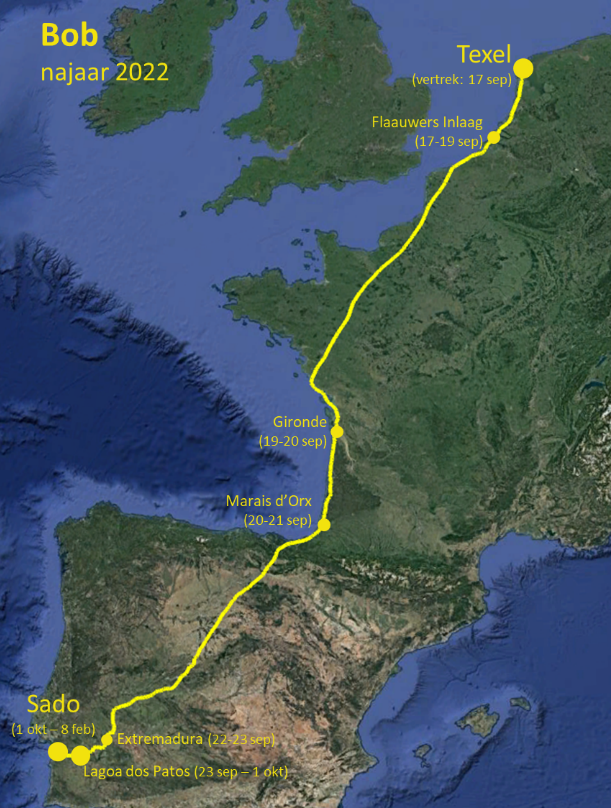
|
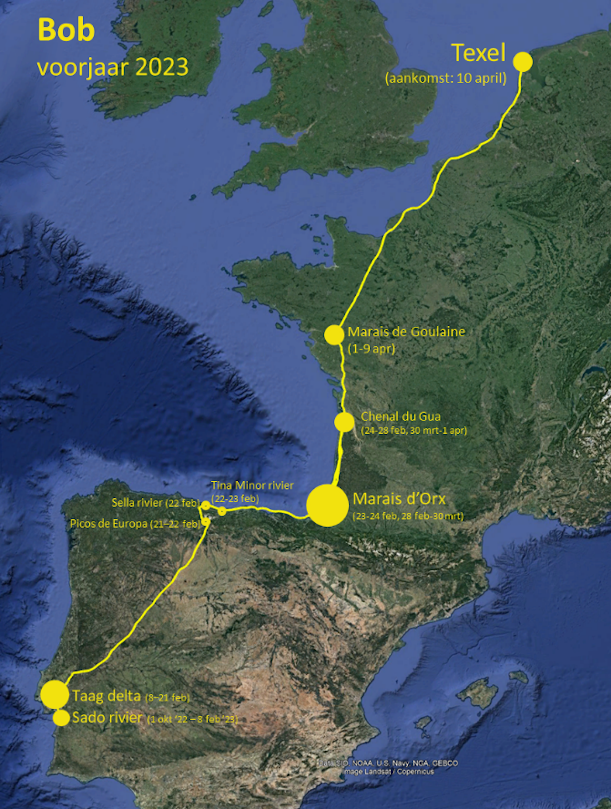
|
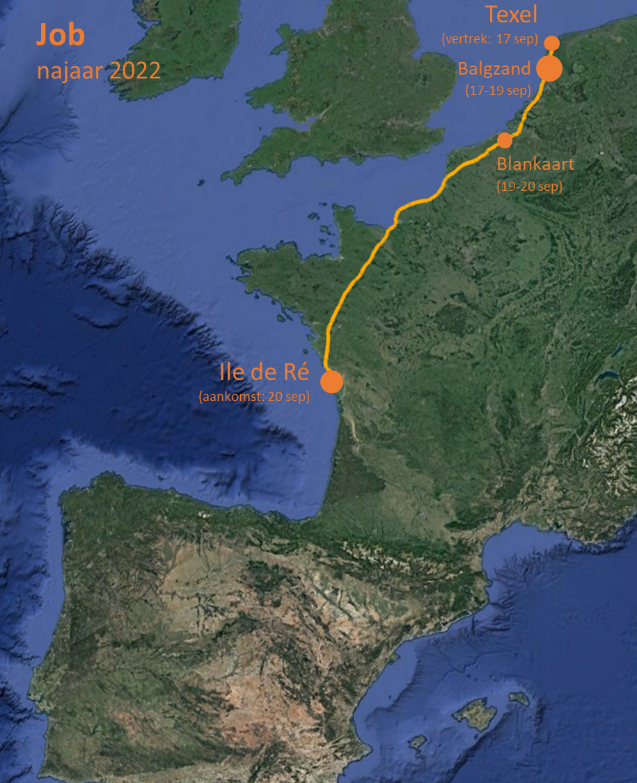
|
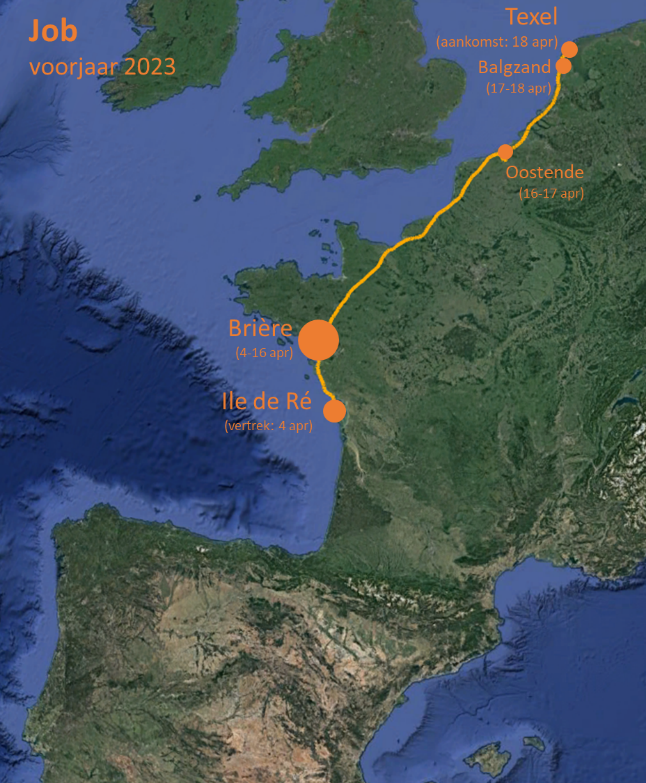
|
Differences between males and females?
From the research on GPS-tracked spoonbills breeding on Schiermonnikoog, we discovered that males and females use different area sduring the breeding season to rest and forage. Males fly larger distances and often forage in the freshwater habitats in the Lauwersmeer while females stay closer to the colony and forage almost exclusively in the gullies and pools in the Wadden Sea that become exposed during low tide. To get a representative view of the areas that spoonblls use around the colony of De Schorren on Texel, it is therefore important to also follow a few female spoonbills, in addition to the males Bob and Job. This spring we successfully managed to catch a female on De Schorren; her name is Marie.
How are the (GPS-tracked) spoonbills doing at De Schorren?
In addition to monitoring which areas are used by spoonbills throughout the year, we also want to know the quality of these areas, and if and how this changes over time. We do this by correlating area use to survival and breeding success. In addition, the GPS-trackers not only measure the location of the bird, but also contain a built-in accelerometer that measures the acceleration in three directions. Using these data, we can assess what the bird is doing (resting, foraging, flying) and even if a prey is being swallowed, as spoonbills make a very characteristic movement when swallowing a prey. Therefore the trackers can assess foraging success (i.e. the number of swallowed prey per unit (foraging) time) and thereby give valuable information about the availability of small fish, shrimp and crustaceans in shallow wetlands and estuaries along the entire geographical distribution. To estimate breeding success at individual level (i.e. of colour-ringed and GPS-tracked birds), we mark the chicks with temporary ringes when they are about one week old. At that age, they are still attached to their own nest. In contrast, when they are old enough to receive their permanent colour-rings (at an age of 3-4 weeks old), the chicks gather together in crèches which makes it impossible to determine from which nest they came. To estimate the breeding success of the GPS-tracked spoonbills at De Schorren, we returned to the colony a week after we caught spoonbill Marie, to mark her chicks. In addition, we hoped to also localize the nests of Bob and Job. However, when we arrived, at low tide in the afternoon, Bob and Job were nowhere to be seen, while Marie stood on her nest with three beautiful chicks. After we marked her chicks and those of the surrounding nests, we retreated from the colony and kept watching from a distance whether Bob and/or Job had returned in the meanwhile with food for their chicks. After a bit of waiting, we indeed discovered spoonbill Bob, and what turned out to our great surprise: Bob stood on the nest of spoonbill Marie, feeding their three chicks! Bob & Marie turned out to be a couple! Job was still nowhere to be seen, but to limit the time of disturbance to the colony and other breeding birds, it was time to leave the saltmarsh; hopefully we get another chance to locae Job’s nest. It will be exciting to see if the three chicks of Bob & Marie will still be alive when we return to colour-ring them. To be continued!
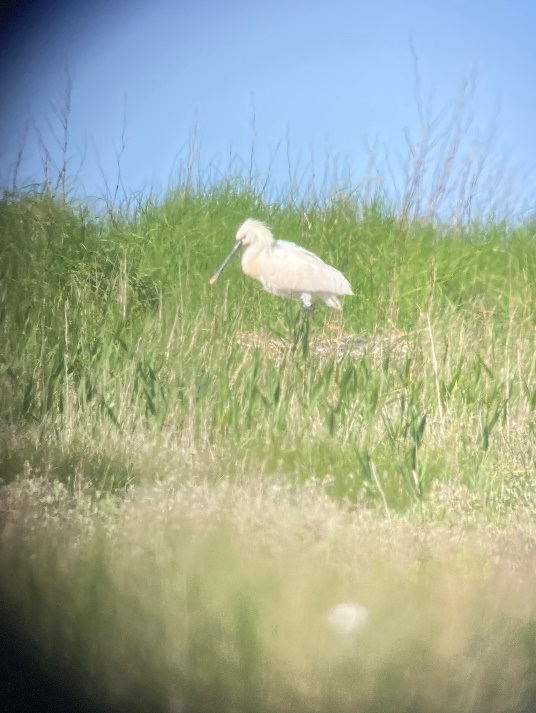 Marie on her nest |
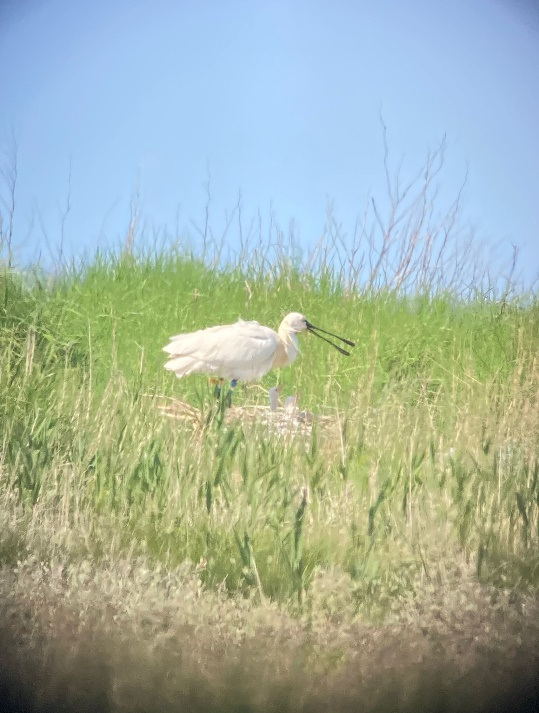 Half an hour later: Bob has relieved Marie and is feeding their young. |
The couple Bob & Marie, as well as Job and the other GPS-tracked spoonbills can be followed live at https://maps.nioz.nl/spoonbills-NL and on the AnimalTracker app.

